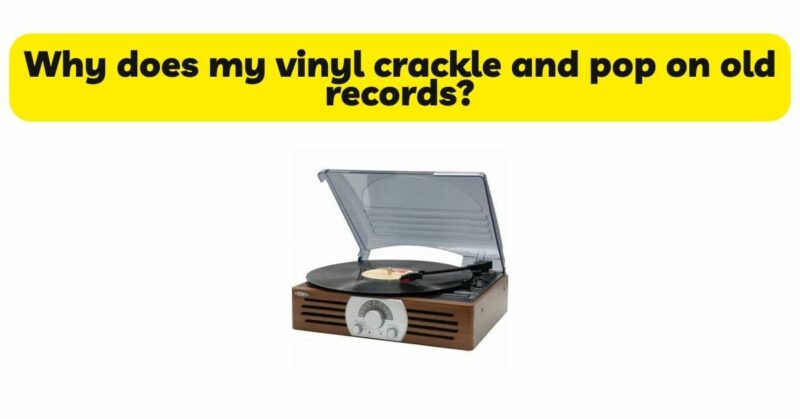Listening to vinyl records, particularly older ones, can be a nostalgic and captivating experience. However, it is not uncommon for these records to exhibit crackles and pops during playback, interrupting the smooth flow of the music. In this article, we will explore the reasons behind crackling and popping on old vinyl records. We will examine factors such as record condition, surface imperfections, wear and tear, storage conditions, and environmental influences that contribute to these audible disturbances. By understanding the causes, we can gain insight into the nature of vinyl playback on old records and discover strategies to minimize crackles and pops for a more enjoyable listening experience.
- Record Condition: The condition of old vinyl records is a significant factor contributing to crackles and pops. Over time, records can accumulate dust, dirt, or debris that settle into the grooves. These contaminants disrupt the smooth movement of the stylus, causing audible disturbances. Additionally, scratches, scuffs, or groove wear accumulated through years of handling and playback can also introduce crackles and pops. Proper cleaning techniques, such as using a record brush or record cleaning machine, can help remove surface contaminants and reduce crackling and popping.
- Surface Imperfections: Old records may exhibit surface imperfections due to the wear and tear they have endured. Microscopic particles, such as dust or debris, can become embedded in the grooves, creating irregularities that cause crackles and pops during playback. Manufacturing defects or damage acquired over time, such as pressing imperfections or warping, can also contribute to these disturbances. While it may not be possible to eliminate all surface imperfections, proper cleaning and maintenance can help minimize their impact.
- Wear and Tear: Vinyl records are not immune to the effects of repeated playback. Each time a stylus traverses the grooves, a small amount of material is gradually worn away. Over time, this wear and tear can lead to groove distortions, uneven surfaces, or accumulated debris, all of which contribute to crackles and pops during playback. Records that have been heavily played or poorly cared for are more prone to these issues. Regular maintenance, such as cleaning and proper stylus care, can help mitigate wear and tear.
- Storage Conditions: The storage conditions of vinyl records can greatly influence their condition and subsequent playback quality. Improper storage, such as exposure to high humidity, extreme temperatures, or direct sunlight, can lead to deterioration of the vinyl material. Warping, mold growth, or the breakdown of the vinyl’s chemical composition can result in crackles and pops during playback. Storing records in a cool, dry environment and using proper protective sleeves can help preserve their condition and minimize these issues.
- Environmental Influences: Environmental factors, both during storage and playback, can impact the condition of old records and contribute to crackles and pops. Fluctuations in temperature and humidity levels can cause the vinyl to expand or contract, leading to surface irregularities and subsequent audible disturbances. Dust and airborne particles can settle on the record surface, interfering with the stylus movement. Additionally, static electricity can attract dust particles, exacerbating crackling and popping issues. Controlling the listening environment and employing anti-static measures can help reduce these environmental influences.
- Age and Quality of Pressing: Older vinyl records, especially those from specific eras or lesser-quality pressings, may exhibit more pronounced crackles and pops. Changes in manufacturing techniques, recording equipment, and mastering processes over time can contribute to variations in the quality of the pressings. Records from the early days of vinyl may have been pressed using different materials or with less advanced technology, which can affect their playback quality. Recognizing the limitations inherent to older pressings can help set realistic expectations.
- Subjective Perception: It is essential to acknowledge that crackles and pops, to some degree, can be part of the vinyl listening experience and even valued by enthusiasts. Some listeners appreciate these audible artifacts as they evoke a sense of nostalgia, authenticity, or the unique charm of the analog format. However, excessive crackling and popping can detract from the overall enjoyment of the music. The perception of what is considered acceptable or desirable varies among individuals, and personal preferences play a role in determining the tolerance for crackles and pops.
Conclusion: Crackles and pops on old vinyl records can be attributed to factors such as record condition, surface imperfections, wear and tear, storage conditions, environmental influences, age, and quality of pressing. Understanding these causes allows us to appreciate the unique nature of vinyl playback on older records. While it may not be possible to completely eliminate crackles and pops, proper cleaning, maintenance, storage, and environmental control practices can significantly minimize their impact. Embracing the inherent characteristics of older records, including the occasional crackles and pops, can enhance the authenticity and charm of the vinyl listening experience. By striking a balance between preservation and enjoyment, we can immerse ourselves in the captivating world of vinyl and rediscover the music of the past.


